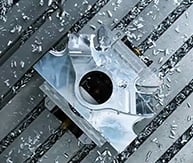
If you’re looking for ways to differentiate your CNC machine shop from the rest of the herd, consider going after work that may mean upgrading your ability to produce more challenging parts. Expanding into aerospace and other industries for which milling complex parts is expected, for example requires some forethought in terms of both equipment and techniques. Here are 7 things to think about when milling complex parts:
- Study the part carefully so you can develop a strategy for machining. The goal is to make the part with the fewest setups, operations and least amount of operator intervention. You’ll also want to establish procedures that eliminate or reduce any variances from part-to-part.
- Although Computer Aided Design (CAD) and Computer Aided Manufacturing (CAM) are helpful, the CAM files should be seen as a starting point for developing your strategy. Often you can improve on the CAM procedures by making adjustments to better match your specific equipment and applying your experience.
- Consider the size and features of the part to determine the best approach. Ask yourself, for example, “What do these features tell me in terms of possible tool deflection or distortion?”
- Another critical factor is the material you use to make the part. For instance you may need to consider special tooling if you’re working with exotic alloys or other hard to machine metals You’ll also need to think about the different kinds of tools required for various features, and the tool holding capacity of the machine tool.
- Once you have a good handle on the part features and what is required to achieve them, you can group similar operations together to reduce the number of times a part must be repositioned.
- In many cases the ability to competitively produce complex parts requires CNC machining centers with multiple axes and functions. 5-axis machining centers are often the best choice, because they enable users to machine many complex parts in one setup, and eliminate the need to move parts from one machine to another.
- Because milling complex parts is so complicated, the CNC machine you use must have the fundamental capabilities to maintain accuracies while performing diverse functions. Things to look for in a machine include: A rigid spindle and tool holder to eliminate the vibrations and cutter run-out that cause out-of-tolerance parts; the ability to maintain constant spindle speed; a machine control system that maintains consistent acceleration and deceleration.
Your Torrance Haas Factory Outlet will help you choose the best CNC machines for milling complex parts, backed by service and support to keep you running ahead of the pack. Call (310) 381-0750, email: jphillips@haasfactoryoutlet.com, or visit www.haasfactoryoutlet.com.